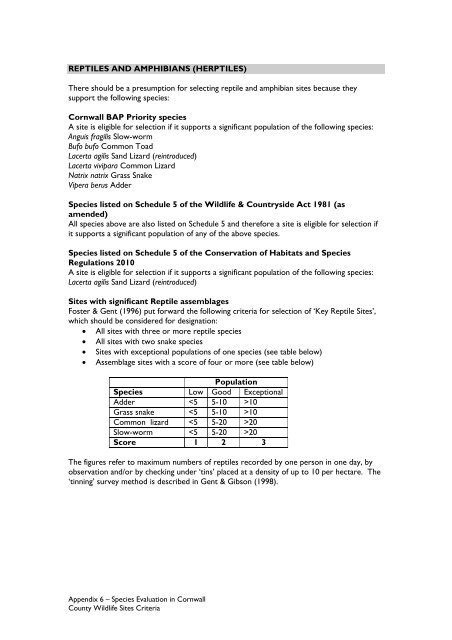County Wildife Site Criteria for Cornwall Appendices
County Wildife Site Criteria for Cornwall Appendices
County Wildife Site Criteria for Cornwall Appendices
Create successful ePaper yourself
Turn your PDF publications into a flip-book with our unique Google optimized e-Paper software.
REPTILES AND AMPHIBIANS (HERPTILES)There should be a presumption <strong>for</strong> selecting reptile and amphibian sites because theysupport the following species:<strong>Cornwall</strong> BAP Priority speciesA site is eligible <strong>for</strong> selection if it supports a significant population of the following species:Anguis fragilis Slow-wormBufo bufo Common ToadLacerta agilis Sand Lizard (reintroduced)Lacerta vivipara Common LizardNatrix natrix Grass SnakeVipera berus AdderSpecies listed on Schedule 5 of the Wildlife & Countryside Act 1981 (asamended)All species above are also listed on Schedule 5 and there<strong>for</strong>e a site is eligible <strong>for</strong> selection ifit supports a significant population of any of the above species.Species listed on Schedule 5 of the Conservation of Habitats and SpeciesRegulations 2010A site is eligible <strong>for</strong> selection if it supports a significant population of the following species:Lacerta agilis Sand Lizard (reintroduced)<strong>Site</strong>s with significant Reptile assemblagesFoster & Gent (1996) put <strong>for</strong>ward the following criteria <strong>for</strong> selection of ‘Key Reptile <strong>Site</strong>s’,which should be considered <strong>for</strong> designation: All sites with three or more reptile species All sites with two snake species <strong>Site</strong>s with exceptional populations of one species (see table below) Assemblage sites with a score of four or more (see table below)PopulationSpecies Low Good ExceptionalAdder 10Grass snake 10Common lizard 20Slow-worm 20Score 1 2 3The figures refer to maximum numbers of reptiles recorded by one person in one day, byobservation and/or by checking under ‘tins’ placed at a density of up to 10 per hectare. The‘tinning’ survey method is described in Gent & Gibson (1998).Appendix 6 – Species Evaluation in <strong>Cornwall</strong><strong>County</strong> Wildlife <strong>Site</strong>s <strong>Criteria</strong>
















